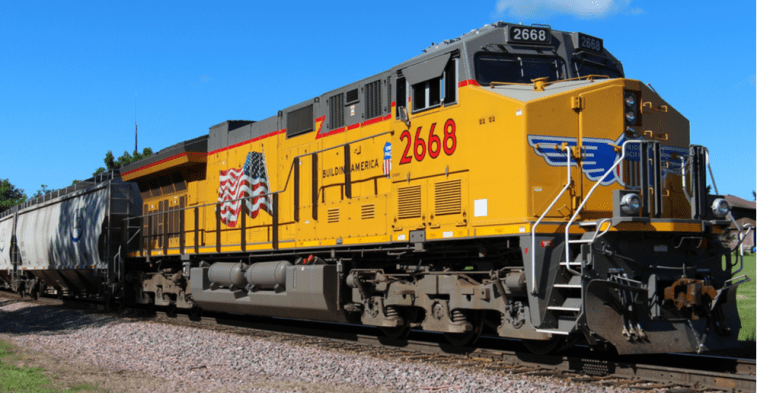INTERMODAL IS HOT: HOW SIX CITIES ARE MEETING LONG-HAUL CHALLENGES
How hot is intermodal right now? Total volumes rose 20.4% year-over-year in the second quarter of 2021, according to the Intermodal Association of North America (IANA) Intermodal Quarterly report.
International containers gained 24.8% from 2020; domestic shipments, 15.7%; and trailers, 18.5%, according to the Calverton, Maryland-based association’s report, which also found that intermodal volumes not only grew for the fourth consecutive quarter in Q2, but the double-digit gain was the largest quarterly increase since Q3 of 2010 as well as the sixth quarter with a double-digit growth rate in the history of the data.
“What is noteworthy is the breadth of the gains,” said Joni Casey, president and CEO of IANA, before September’s IANA Expo in Long Beach, California, where the Q2 surge was a source of industry optimism. “With one or two exceptions, the three market segments showed positive performance in all of IANA’s 10 regions.”
Trans-Canada led with a 29.6% total growth increase, followed by the Southeast-Southwest at 28.9% and the Midwest-Northwest at 26.6%. The Intra-Southeast likewise posted a 25.9% increase; the South Central-Southwest, 24.5%; and the Midwest-Southwest, 21.8%. The Northeast-Midwest came in at 20.9%.
“Freight volumes are expected to slow but experience steady q/q growth into 2022,” forecasts the 2021 Second Quarter Intermodal Quarterly report. “For 2021 as a whole, truck loadings are forecasted to be 7% higher than 2020 levels.”
Freight demand pressures, the end of consumer stimulus infusions and unemployment supplement and the ongoing surge in small new trucking companies have complicated matters, according to the report. “Intermodal remains highly competitive with trucking due to very high rates and tight driver supply.
This situation will likely continue at least into early 2022, however, could be affected by a quicker stabilization in the trucking market, as reflected by a peak in truck spot metrics.”
Managing the ups and downs of intermodal transport is greatly assisted by the IANA, whose roster includes more than 1,000 members from railroads, ocean carriers, ports, intermodal truckers and over-the-road highway carriers, intermodal marketing and logistic companies, and suppliers to the industry. (Learn more at intermodal.org.) But at the hyper-local level, economic development corporations (EDCs) also play a role in keeping freight trains rolling. Below are six cities meeting intermodal challenges with the help of their EDCs.
MILLERSBURG, OREGON
The Albay-Millersburg Economic Development Corporation estimates that 81% of the exported agricultural products from the Mid-Willamette Valley of Southern Oregon are loaded onto ships at the Seattle and Tacoma ports, with the remainder exported from ports in Long Beach (8 percent) and Oakland (3 percent), California.
Complicating the flow of produce is traffic congestion near Portland, Seattle, Tacoma and farther down Interstate 5 into California.
However, like an oasis of calm sits Millersburg, which allows agricultural producers in the region to consolidate their products efficiently and avoid bumper-to-bumper nightmares altogether. To that end, the Linn Economic Development Group (LEDG), which is an affiliate of the Albay-Millersburg EDC, is constructing the Mid-Willamette Valley Intermodal Center (MWVIC) in Millersburg.
The town of around 2,000 people just happens to be where the Union Pacific Railroad mainline, BNSF’s Portland Western Railroad and I-5 come together. The MWVIC was made possible by passage of the state’s Keep Oregon Moving legislation, which appropriated $25 million toward development.
The intermodal center will include a main office, parking lot, space for about 100 trucks to park overnight, amenities for truck drivers, capabilities to handle domestic and international containers, track space for inbound and outbound trains, a 60,000-square-foot storage warehouse and docks to support reloading and transloading onto rail, with capacity for longer-term storage of product.
Agricultural producers and train operators are not the only beneficiaries of the project. Shippers will now have the option of choosing the best transportation alternative for each individual load. The LEDG estimates that under full utilization, private transportation cost savings will total $2.1 million per year.
But the public should turn out to be the biggest winner. Reducing the number of trucks on the highways would lower maintenance costs, reduce congestion, improve air quality and decrease carbon emissions—while the MWVIC at the same time increases jobs and local spending.
ALLENTOWN, PENNSYLVANIA
The Norfolk Southern Allentown Rail Yard is among the railroad’s largest facilities, but only a few of the 200 manufacturers in the Pennsylvania town transport goods by rail. The Allentown Economic Development Corporation would like to change that. Saying of the yard “we’re very fortunate to have it,” Scott Unger, executive director of the Allentown EDC, says he and his team are pulling out all the stops to increase rail usage.
Pennsylvania’s Bureau of Rail Freight administers a special grant program called the Rail Freight Assistance Program that provides financial assistance to companies that are interested in bringing a railroad spur directly to their property for freight shipments. The goal of the grant program is to preserve and stimulate economic development through new and expanded rail service.
Also hoping the state incentive program lights a fire under local manufacturers is the R. J. Corman Railroad Co., LLC, which owns 11 Class 3 short line railroads in the Mid-Atlantic and the South, as well as the R. J. Corman Allentown Rail Yard.
“Products that are ideal for transloading include palletized commodities which can be loaded and unloaded in a boxcar,” explained John Gogniat, director of Commercial Development for R. J. Corman. “In addition, products such as lumber or steel that can be unloaded with a forklift are ideal candidates. That said, we are open to entertaining any potential commodity and will develop a mutually desirable solution for its loading and unloading.”
Gogniat notes that Allentown’s strategic location provides access to Philadelphia, Scranton, York, Harrisburg, Wilmington, New York and beyond.
WILKES COUNTY, NORTH CAROLINA
The North Carolina Department of Transportation’s Rail Industrial Access Program also uses state funds to help construct or refurbish railroad spur tracks required by a new or expanding company. Program funding is intended to modernize railroad tracks to ensure effective and efficient freight deliveries.
Many companies taking advantage of the incentive are located in Wilkes County, which was established in 1777 and is still known today as a mecca for outdoor recreation, small-town living . . . and a big business mentality.
Consider the Yadkin Valley Railroad, which offers Wilkes County businesses rail access to ship their products into the Ronda and Roaring River areas. Operating out of the Winston-Salem area and hauling 11,500 carloads per year with freight, Yadkin joins G&O’s short line railroads, which offer connections to CSX and Norfolk Southern, in figuring into the logistical operations of Charlotte Regional Intermodal Facility.
Wilkes County Economic Development Corporation will point businesses to other local and state incentive programs to improve rail access—dependent on the applicant’s potential to create new jobs and invest capital in the region. The aim is to get companies to locate or expand in North Carolina versus another state.
“The North Carolina Railroad Company partners with the state’s economic development community and railroads on initiatives designed to drive job creation, freight rail use and economic growth,” reads an EDC release. “Through NCRR Invests we evaluate requests for investments to address the freight rail infrastructure needs of companies considering location or expansion in the state.”
But Wilkes County does not live by rail alone, as the EDC also trumpets a location that is close to major freeways and interstates, two international airports (Charlotte Douglas and Piedmont Triad) and three major East Coast ports (Wilmington, North Carolina; Norfolk, Virginia; and Charleston, South Carolina).
NEW YORK, NEW YORK
An ambitious program was born out of congestion, pollution and unconnected cargo transportation options in the Big Apple. Freight NYC aims to expand the use of rail and water to move food, building materials and other goods that are normally trucked in from outside the five boroughs.
“Freight NYC will better equip New York City to meet 21st-century demand by modernizing the city’s freight infrastructure, reducing truck traffic and improving air quality, while creating nearly 5,000 good-paying jobs in the process,” says James Patchett, chief executive of the New York Economic Development Corporation. “This plan is a win-win for our environment and economy.”
The city would invest as much as $100 million in the program that would include a 500,000-square-foot distribution center on the site of the Brooklyn Army Terminal, adjacent to the New York New Jersey Rail carfloat hub, as well as a new air cargo center near John F. Kennedy International Airport in Queens.
Private participation in a $20-30 million barge terminal on five acres of land owned by the city in Hunts Point, a major distribution crossroads for produce in the Bronx, is also part of the multimodal plan.
Small rail freight yards on a line through Brooklyn and Queens, where goods would be transloaded to smaller vehicles for final delivery, is also envisioned.
DECATUR, ILLINOIS
When you think of the granddaddy of rail operations in the Midwest, you think of Chicago. That’s part of . . . heck, the main problem, according to Nicole Bateman, president of the Decatur Economic Development Corporation and executive director of the Midwest Inland Port. The Windy City is not only the nation’s busiest rail freight gateway, it’s the third-largest intermodal container/trailer port in the world, following Singapore and Hong Kong, according to the Illinois Department of Transportation.
What comes to mind when you think about freight, Singapore and Hong Kong? Congestion. As such, shippers on both ends of the supply chain need alternatives to Chicago—which is where Decatur (as Bateman’s fingers cross) comes in.
Located 160 miles southwest of Chicago, Decatur is now being propped up by its EDC and the Midwest Inland Port as a distribution transportation center, which is fed not only by four railroads but easy access to interstates and airports. The port association is utilizing public-private partnerships to capitalize on Decatur’s geographic location, while the EDC seeks to make the city Illinois’ designated downstate freight transportation hub as a way to relieve rail and highway congestion in Chicago.
Users of the Midwest Inland Port have experienced savings in freight transportation costs and significant reduction in transit times, Bateman recently told American Shipper.
SEGUIN, TEXAS
Talk about strategic locations, Seguin sits alongside Interstate 10 and the banks of the Guadalupe River, with San Antonio a mere 35 minutes to the west, Austin only 55 minutes north and Houston about 2 ½ hours to the east.
Besides the easy access to I-10, Seguin also connects to State Highway 130, which it bills as “the safe, fast and reliable alternative to congested Interstate 35 in Central Texas.” Two international airports (San Antonio and Austin-Bergstrom) and two deep-water ports (Houston and Corpus Christi) are an hour of so away.
But perhaps the biggest jewel in the close proximity crown is Union Pacific’s San Antonio Intermodal Terminal (SAIT), a $100 million state-of-the-art facility designed to support the growing intermodal volume in southern Texas. The expansive facility is designed to handle 250,000 annual container lifts as it serves markets across South Texas.
If that hasn’t sold you, allow the Seguin Economic Development Corporation to work its magic. The EDC helps guide businesses through the maze of available loans, grants and tax breaks from the city, county and state. To hear the EDC tell it, finding applicants should be no sweat considering Seguin’s “easy access to four of the United States’ largest consumer markets, allowing manufactures to get their products to millions of consumers, all within a five-hour drive.”





Leave a Reply